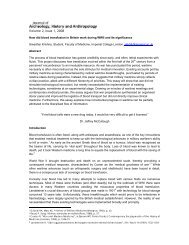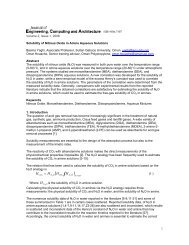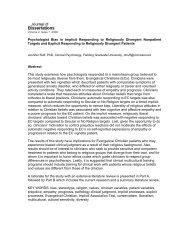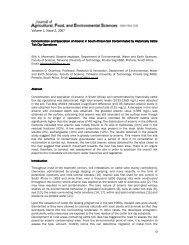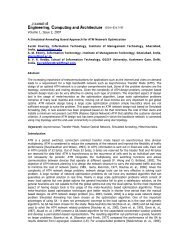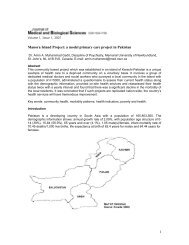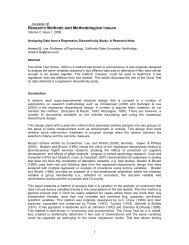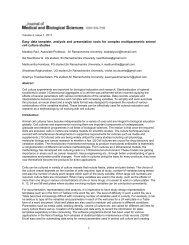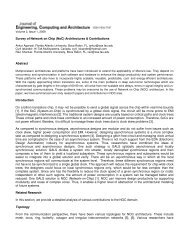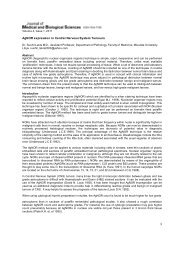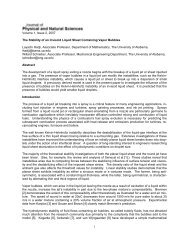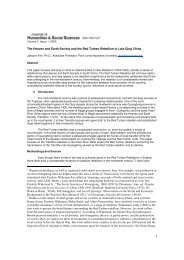Volume 1, Issue 2, 2007 E-Class as a Step toward Solving e ...
Volume 1, Issue 2, 2007 E-Class as a Step toward Solving e ...
Volume 1, Issue 2, 2007 E-Class as a Step toward Solving e ...
Create successful ePaper yourself
Turn your PDF publications into a flip-book with our unique Google optimized e-Paper software.
<strong>Volume</strong> 1, <strong>Issue</strong> 2, <strong>2007</strong><br />
E-<strong>Cl<strong>as</strong>s</strong> <strong>as</strong> a <strong>Step</strong> <strong>toward</strong> <strong>Solving</strong> e-Learning Problems: Analytical Study for the SQU C<strong>as</strong>e<br />
Naeema H. Jabr, Associate Professor, Department of Library and Information Science, Sultan Qaboos<br />
University, Oman, mnjaburh@hotmail.com<br />
Sabah Abdul-Kareem Kallow, Assistant Professor, Department of Library and Information Science, Sultan<br />
Qaboos University, Oman, sabahk@squ.edu.om<br />
Mousa Al-Kindee, \<strong>as</strong>sistant Orofessor, College of Education, Sultan Qaboos University, Oman,<br />
mkindi@squ.edu.om<br />
Abstract<br />
As e-learning is becoming a growing trend in today’s educational system, much attention h<strong>as</strong> been given<br />
to its different practices, such <strong>as</strong> e-cl<strong>as</strong>s and online courses. This is motivated by the need to incre<strong>as</strong>e<br />
the value of cl<strong>as</strong>sroom exercises <strong>as</strong> a teaching tool by improving communication, understanding, and selflearning<br />
in order to incre<strong>as</strong>e the speed of information transfer, processing, and utilization.<br />
Sultan Qaboos University (SQU) h<strong>as</strong> utilized e-learning since September 2001 through the WebCT and<br />
Moodle, thus taking advantage of the many benefits of the new information and telecommunication<br />
technologies. Such an innovation h<strong>as</strong> helped faculty to use WebCT <strong>as</strong> an aid to traditional cl<strong>as</strong>s. This<br />
study, however, proposes that e-cl<strong>as</strong>s is made an alternative application to the traditional cl<strong>as</strong>s. The main<br />
purposes underlying this suggestion are: (a) to take advantage of the available expertise to teach either a<br />
larger number of students or several cl<strong>as</strong>ses simultaneously, (b) to take advantage of the available<br />
demonstrators and technicians to help control cl<strong>as</strong>ses and communications, (c) to disseminate electronic<br />
literacy, which is considered to be the main characteristic of the current era, <strong>as</strong> well <strong>as</strong> to make the<br />
interactive opportunities available to lecturers, demonstrators, and students, and (e) to participate in the<br />
international trends <strong>toward</strong> electronic learning. To achieve the above purposes, two different faculty and<br />
student questionnaires were developed. 297 students, 29 faculty members, and 3 technicians were<br />
selected <strong>as</strong> the main audience of the study. In most c<strong>as</strong>es, around 60% of the students showed that the<br />
main shortcomings of e-learning come from the style appearance of faculty to provide better course<br />
quality. Reflections and attitudes average mean scores <strong>toward</strong> the effectiveness of e-learning and the<br />
organization of materials show no differences among science and social science respondents, the only<br />
significant differences being found between medical science and sciences respondents in terms of<br />
knowledge integration.<br />
Keywords: e-cl<strong>as</strong>s learning, e-learning, online course, Sultan Qaboos University,<br />
Introduction<br />
Multimedia and web-enhanced learning h<strong>as</strong> become incre<strong>as</strong>ingly attractive to universities, both for<br />
financial and technological re<strong>as</strong>ons. Today, developing teaching and curriculum with technological<br />
facilities involves, in some way, introducing e-learning, <strong>as</strong> a part technology in order to <strong>as</strong>sist both<br />
students and teachers. As a result, capturing cl<strong>as</strong>sroom lectures for later access, following up new<br />
readings, and tracing discussions on current issues have become popular research topics with several<br />
different approaches and contributions. This may involve a lecturer in creating course websites,<br />
integrating online discussions or even bringing together computer-b<strong>as</strong>ed resources to support a subject<br />
area. With e-learning come new issues and responsibilities that may be sensitive to how technologyb<strong>as</strong>ed<br />
methods and materials are introduced and integrated into learning and teaching. Evaluation of the<br />
current applications can provide a framework for thinking about such matters and can help judge the<br />
required changes in practice which could be beneficial to developing e-cl<strong>as</strong>s. In addition, evaluation offers<br />
a means to investigate, provide evidence, learn, share and make judgments about what we do and how<br />
we do it. For the university, evaluation is important in order to ensure the quality of academic practice <strong>as</strong><br />
it plans and finances the program of WebCT to be side by side with traditional teaching and training.<br />
Education h<strong>as</strong> traditionally consisted of a student or group of students receiving instruction from a teacher<br />
with everyone collected in one location. E-learning is changing the way instruction happens today. E-<br />
learning is the acquisition of knowledge and/or skills wherein time and/or space separates the learner and
provider. This occurs for the purpose of giving students and teachers more flexibility and options<br />
concerning when and how to study and teach. In general, the potential of web-enhanced learning h<strong>as</strong><br />
become incre<strong>as</strong>ingly attractive to universities, both for financial and technological re<strong>as</strong>ons.<br />
B<strong>as</strong>ically, the success or failure of e-learning rests on the enthusi<strong>as</strong>m with which educational technologies<br />
are embraced by the faculty, administrators, and students. Alexander (1995) states that, computers<br />
would serve <strong>as</strong> patient tutors, scrupulous examiners and tireless schedulers of instruction. Furthermore,<br />
the benefits to students include the freedom to follow their own paths of learning, at their own pace.<br />
They will have immediate access to their lecturers, who can work individually with each student through<br />
the discussion board and e-mail. While Kulik, Kulik and Cohn (1980) emph<strong>as</strong>ize that the previous studies<br />
of the 1960s and 1970s in this field, aimed at supporting the effectiveness of computer-b<strong>as</strong>ed teaching <strong>as</strong><br />
a supplement to conventional teaching.<br />
Actually, converting face-to-face lecture offerings to electronic delivery formats is one of the greatest<br />
challenges facing faculty, administrators, and students at both the undergraduate and graduate level. In<br />
addressing this challenge, it is evident that there are many approaches to managing e-learning<br />
development applying different formats and appeared in different names to handle the process of e-<br />
learning. With just a quick browsing through the internet, searching for the topic, one can find thousands<br />
of sites using the following terms: (date of browsing is: 5/12/2005)<br />
- “e-Learning” (43,600,000 site)<br />
- “internet learning” (223,000 site)<br />
- “online learning” (13,700,000 site)<br />
- “Distance learning” (45,600,000 site)<br />
- “Web-b<strong>as</strong>ed learning” (1,130,000 site)<br />
- “Virtual learning“ (1,690,000 site)<br />
- “e-cl<strong>as</strong>s” (1,950,000 site)<br />
- “Virtual e-cl<strong>as</strong>s” (36 site)<br />
- “e-chalk“ (13,200 site)<br />
- “e-courses” (309,000 site)<br />
- “online courses” (37,600,000 site)<br />
The search w<strong>as</strong> repeated on 9/7/2006 (seven months later) and the results were:<br />
- “e-learning” (142,000,000 site)<br />
- “internet learning” (376,000 site)<br />
- “online learning” (39,600,000 site)<br />
- “Distance learning” (96,600,000 site)<br />
- “Web-b<strong>as</strong>ed learning” (1,820,000 site)<br />
- “Virtual learning“ (4,610,000 site)<br />
- “e-cl<strong>as</strong>s” (4,000,000 site)<br />
- “Virtual e-cl<strong>as</strong>s” (6 site)<br />
- “e-chalk“ (18,100 site)<br />
- “e-courses” (3,310,000 site)<br />
- “online courses” (24,100,000 site)<br />
In general, e-learning is a growing trend in today’s educational system and the terms “e-cl<strong>as</strong>s” and<br />
“online courses” become more popular <strong>as</strong> if they are synonymous with e-learning. About two-thirds have<br />
the accredited four-year colleges and graduate schools in the United States complement their campus<br />
cl<strong>as</strong>s-offerings with cl<strong>as</strong>ses via the internet.(Perrin and Mayhew, 2000). As the number of universities<br />
and other institutions applying e-learning programs incre<strong>as</strong>e, the styles and methods being applied<br />
incre<strong>as</strong>e too. Currently, Henderson (2003) mentions three b<strong>as</strong>ic styles of e-learning, which are:<br />
1- Synchronous Learning: means "real time" where a group of students meet with an instructor<br />
over the Internet. They are all online at the same time while they are communicating with each<br />
other. The instructor can interact with the students, and students can interact with other<br />
students. In other words, all students and the instructor are "there" at the same time. There<br />
are scheduled on-line meetings with other students and teachers, which can include live chats<br />
and videoconferencing. This requires collaboration and communication at agreed times, so it is<br />
much like the traditional cl<strong>as</strong>sroom experience except the "there" is online instead of physically<br />
1
together. The word synchronous, then, means "all at the same time" and refers to the<br />
"gathering of all the students at the same time". With this method, there are greater<br />
opportunities for socialization, but reduced flexibility because 24-hour access is rarely possible<br />
since students could be in different places and different time zones around the world or students<br />
who could be busy with their day jobs while they are trying to take an e-course before or after<br />
work.<br />
2- Self-Directed Learning Style: Means students act alone to work through the material stepby-step,<br />
that is, "teach yourself" type of education. Each module of such a style might have:<br />
a. Text to read (the analog of reading a book)<br />
b. Recorded lectures to listen to<br />
c. Self-check quizzes to take<br />
d. Simulation to practice<br />
3- Asynchronous (collaboration) Learning Style: means that material posted to the program<br />
can be accessed at any time, twenty-four hours a day, seven days a week. This style blends the<br />
characteristics of the other two styles. A group of students meet with an instructor over the<br />
Internet and can communicate, but not necessarily online, at the same time. Students act alone<br />
to study material and interact by learning messages that are expected to be responded to within<br />
a matter of hours.<br />
E-cl<strong>as</strong>s, on the other hand, is an educational entity where its design depends on the use of<br />
information and telecommunication technologies for the purposes that make time and place<br />
less of a factor. It achieves online communication between the teacher and his/her students<br />
in many cl<strong>as</strong>ses at the same time.<br />
Why E-cl<strong>as</strong>s?<br />
The incre<strong>as</strong>ed use of interactive exercises such <strong>as</strong> e-learning and simulations <strong>as</strong> well <strong>as</strong> online training, is<br />
considered to be one of the most important developments in social, economics, and business pedagogy.<br />
In fact, computerization and telecommunication greatly incre<strong>as</strong>e the value of cl<strong>as</strong>sroom exercises <strong>as</strong> a<br />
teaching tool by improving communications, understanding, and self-learning, and incre<strong>as</strong>ing the speed of<br />
information transfer, processing, and utilization.<br />
From the learning point-of-view, if we <strong>as</strong>sume that different students learn in different ways –some prefer<br />
reading, others learn by doing, some prefer visual contacts others face to face, and so on-then different<br />
tools are required. One useful benefit that e-learning offers is a framework and knowledge set of tools to<br />
place learning resources and to think in a pedagogical way about learning. Furthermore, since<br />
computerization decre<strong>as</strong>es the burden of running a cl<strong>as</strong>s in terms of time constraints, complex exercises<br />
and the incre<strong>as</strong>ed number of students within each group, instructors will be able to offer students<br />
significantly more time, more opportunities to view the lecture individually, and richer, realistic up-to-date<br />
exercises. B<strong>as</strong>ed on this, e-learning will offer the students and trainers substantially richer educational,<br />
practical, and vocational knowledge.<br />
Actually, technology changes the way students think, what they learn, and how they interact with peers<br />
and instructors. In this respect, Perrin and Mayhew (2000) find that taking an online course is merely<br />
either a way to supplement their traditional learning experience or be <strong>as</strong> an alternative to the cl<strong>as</strong>sroom<br />
setting. Whether taking online courses <strong>as</strong> supplements or alternatives, both are considered to be<br />
approaches with the following advantages (Mather, 1998):<br />
- Bringing education from traditional cl<strong>as</strong>s room to the living room of their houses where<br />
everyone in the family can participate.<br />
- The flexibility of e-courses allows students to set their own hours at a pace which is<br />
comfortable for them<br />
- Participants to e-learning can go <strong>as</strong> f<strong>as</strong>t or slow <strong>as</strong> they wish<br />
- E-learning allows students to have more control over their learning experience<br />
In addition to the above advantages, Trinkle (1999) notes that some students who take online courses<br />
actually find that they are drawn into the subject matter more deeply than in traditional courses because<br />
of the online discussions.The role of the instructor within such an experience is changed. Pritchard<br />
(1998) indicates that the instructor in e-learning can play a vital role of serving both <strong>as</strong> a mentor and a<br />
2
humanizer. As a mentor, the instructor acts <strong>as</strong> a resource, directing students to solutions by providing<br />
insight on where to go, who to contact, and how to solve problems in general. And drawing out personal<br />
commitment, participant interaction, and enthusi<strong>as</strong>m, the instructor is seen <strong>as</strong> a humanizer.<br />
E-cl<strong>as</strong>s began with the goal of producing a cl<strong>as</strong>sroom environment in which electronic notes taken by<br />
students and teachers could be preserved and accessed later, augmented by audio and video recordings.<br />
E-cl<strong>as</strong>s h<strong>as</strong> since evolved into a collection of capture-enabled programs that attempt to preserve <strong>as</strong> much<br />
<strong>as</strong> possible of the lecture experience, with little or no human intervention. Generally speaking, the in-cl<strong>as</strong>s<br />
experience to the instructor or students enrolled in a course taught using e-cl<strong>as</strong>s is not significantly<br />
different from a typical cl<strong>as</strong>sroom equipped with modern presentation equipment. While e-cl<strong>as</strong>s will<br />
eliminate or alleviate the need for students to take notes, pen and paper cannot always adequately<br />
capture the richness of a modern cl<strong>as</strong>sroom lecture while they are too busy writing everything down to<br />
pay attention. Hazemi and Hailes (2002) present the goals of e-cl<strong>as</strong>s for faculty, students, and<br />
pedagogical practices <strong>as</strong> follows:<br />
Faculty Goals<br />
• Empower Faculty by providing him/her with the most required software tools for use with<br />
electronic chalkboards.<br />
• Allow professors to fully use the software tools with minimal effort and minimal change to their<br />
current routine.<br />
Student Goals<br />
• Empower students by providing them with the necessary software tools for use both during<br />
cl<strong>as</strong>ses and study. (Although not required, we <strong>as</strong>sume each student h<strong>as</strong> a computer in the<br />
cl<strong>as</strong>sroom. )<br />
• Develop technology to support real time group interaction during cl<strong>as</strong>ses: voting, consensus,<br />
group controlled throttle, etc.<br />
Pedagogical Goals<br />
• Develop technology to support better recording of group activity.<br />
• Support long-term learning and not just memorization for regurgitation on an exam<br />
• Facilitate:<br />
o traditional lectures: electronic blackboards and notebooks,<br />
o student questions and discussion: the student h<strong>as</strong> the ability to use private display to<br />
drive group display,<br />
o<br />
o<br />
small group interactions: students can share displays, and<br />
individual work: students can do back-of-the-envelope calculations using spread sheets<br />
during lectures or discussions mean to explore points.<br />
Specifically, and for the purpose of the current study, advancement in telecommunication technologies<br />
have created opportunities for solving many of the teaching and learning problems, among them, those<br />
related to the availability of qualified faculty members, cl<strong>as</strong>ses timetable, the incre<strong>as</strong>ing number of<br />
students, etc. Therefore, this study is considered to be a response to many such problems, including:<br />
1- The incre<strong>as</strong>ed needs for higher education <strong>as</strong> a consequence of the incre<strong>as</strong>ing number of those<br />
who completed high school, versus the limited number of the already accepted ones;<br />
2- SQU h<strong>as</strong> already developed its educational environment and integrated it with the use of<br />
technologies that could provide quick access to knowledge and achieve the project of e-cl<strong>as</strong>s;<br />
3- The problem of the insufficiency of qualified staff, especially in specialized fields of knowledge, in<br />
light of the incre<strong>as</strong>e in the enrollment of student;<br />
4- The problem of cl<strong>as</strong>s timetable arrangements that could be balanced between the factors related<br />
to the incre<strong>as</strong>ed number of students and limited number of lecturers, and the pressure of time<br />
and place.<br />
3
The Purpose of the Study:<br />
B<strong>as</strong>ed on the above problems, the project of e-cl<strong>as</strong>s could be considered <strong>as</strong> a step <strong>toward</strong> solving these<br />
problems since it leads to:<br />
1- Taking advantage of the available expertise to teach a larger number of students or several<br />
cl<strong>as</strong>ses simultaneously<br />
2- Taking advantage of the available demonstrators and technicians to help control cl<strong>as</strong>ses and<br />
communications<br />
3- Disseminating electronic literacy which is considered to be the main characteristic of the current<br />
era, and to make interactive opportunities available among lecturers, demonstrators, and<br />
students<br />
4- Achieving cost effectiveness for both the university and the society<br />
5- Participating in the international trends <strong>toward</strong> electronic learning<br />
6- Adding more flexibility to the academic and routine works to expand the educational process<br />
beyond the limited time, lecturers, and traditional cl<strong>as</strong>sroom experience.<br />
7-<br />
Statement of the Problem:<br />
In general, besides the advantages mentioned above, Russell (2001) reports several unfortunate<br />
consequences of e-learning in relation to what he call "virtual schooling", including:<br />
• Students will not develop a deep understanding of their own emotions, or that of others. Without<br />
the full bandwidth of face-to-face interaction, understanding of reactions can be reduced.<br />
• The opportunity to form patterns of life-long friendship, which will be reduced. Children often<br />
meet others at school who remain important to them for many years.<br />
• By emph<strong>as</strong>izing the cognitive domain at the expense of the affective, understanding is reduced.<br />
It is much e<strong>as</strong>ier to teach facts with the use of a computer than to make people wise.<br />
• As the face-to-face component of subjects is reduced, the school subjects themselves will<br />
change, and become less rich. The teaching method will affect the content.<br />
• Differences in learning styles will mean that some students may learn less effectively than before.<br />
Conventional schools do not suit everybody, and it would be very surprising if virtual schools<br />
would be satisfactory for everyone.<br />
• Virtual schools may be promoted due to the self-interest of the economist, bureaucrat, or on-line<br />
entrepreneur, rather than on the evidence of educational research or merit.<br />
• Resentment by those who are unhappy with the virtual approach can lead to disruption. Just <strong>as</strong><br />
some students disrupt their cl<strong>as</strong>ses because they dislike conventional schools, it is likely that<br />
some virtual students will make life difficult for their parents or for the community where they<br />
study.<br />
• The long-term effect on the relationships of future adults and their society is unknown. It is a<br />
possibility that poor socialization will lead to problems in the years ahead.<br />
Tracing these disadvantages through the evaluation of the current applications of WebCT at SQU<br />
becomes a critical issue. Although the university invests a large amount of its budget on supporting<br />
online and e-learning activities, little efforts have been made to evaluate the experience. Thus, our<br />
research question and the hypotheses below are tested to evaluate the current practice in order to justify<br />
the decision <strong>toward</strong> applying e-cl<strong>as</strong>s <strong>as</strong> an alternative practice. The research questions and the<br />
hypotheses below are divided into two parts, one related to students’ evaluation and the second to faculty<br />
evaluation, <strong>as</strong> follows:<br />
Students Part:<br />
1- Can we consider the e-cl<strong>as</strong>s <strong>as</strong> an alternative that may solve the shortages and<br />
disadvantages of e-Learning practices?<br />
Answering the question below requires insight into the available applications (WebCT), and this is the<br />
main concern of the study.<br />
4
2- Are there significant differences in the means scores of three factors (effectiveness,<br />
organization and clarity, and knowledge integration) among groups of different<br />
colleges?<br />
3- Are there significant differences in the means scores of the three factors among the<br />
two groups of the science and social science colleges ?<br />
Faculty Part:<br />
The purpose of this part of the questionnaire is:<br />
1- To identify:<br />
• The faculty members’ level of technological skills from their point of view<br />
• Approaches that they depend upon to develop their technological skills<br />
• The main characteristics which shape their use and participation in developing their courses<br />
with the use of WebCT<br />
2- To find out their use and application of the WebCT tools, including:<br />
• The content tools<br />
• The communication tools<br />
• The <strong>as</strong>sessment tools<br />
• The study tools.<br />
3- To evaluate the faculty respondent's attitudes <strong>toward</strong> the use of the WebCT <strong>as</strong>:<br />
• Teaching aid.<br />
• <strong>Cl<strong>as</strong>s</strong> management.<br />
• A tool for <strong>as</strong>sessment.<br />
4- In addition to the above, the study is intended to test the following hypothesis:<br />
Are there significant differences between the two groups (Sciences and Social<br />
Sciences) in their level scores of their attitudes <strong>toward</strong> the WebCT <strong>as</strong>:<br />
• A teaching aid<br />
• <strong>Cl<strong>as</strong>s</strong> management<br />
• A tool for <strong>as</strong>sessment.<br />
Justification of the Study<br />
Me<strong>as</strong>uring e-learning experiences and standards at any organization can offer insight into new<br />
approaches or provide an opportunity to self-evaluate approaches. If we define the features of most<br />
forms of distance education in the way that learners and teachers are not within eyesight of each other,<br />
e-cl<strong>as</strong>s, can then bridge this gap by offering such an opportunity. It is supposed to be a course<br />
management system that enables the efficient delivery of high quality online education. For<br />
administrators, evaluation will serve <strong>as</strong> a means in future planning of investment in technology and<br />
human resources’ development. For students, e-cl<strong>as</strong>s permits access to materials to foster interactivity<br />
among them and between them and their teachers. It is important to remember that with e-cl<strong>as</strong>s a<br />
human guide is made available in the form of a faculty member, or instructor who leads the student<br />
group directly <strong>toward</strong> a learning goal.<br />
The overall aim of the evaluation, however, is to ensure that the e-learning practice and its b<strong>as</strong>ic<br />
outcomes are of clear benefit to the SQU community and is perceived <strong>as</strong> good value for money. This will<br />
lead us to the decision of whether or not a new development of electronic practice that enhances<br />
education and a means to integrate it into everyday use of technology in learning is required. The main<br />
point here is that e-cl<strong>as</strong>s will carry the advantages of both e-learning and traditional learning that places<br />
emph<strong>as</strong>ize on face to face communication.<br />
The objectives of the study can then be abstracted from the advantages of e-<strong>Cl<strong>as</strong>s</strong> theme to ensure that:<br />
1. <strong>Solving</strong> the problem of miss-communication between lecturer and student in announcing an important<br />
message. A lecturer can give a ‘lecturer note and tutorial’ to his/her student at any time.<br />
5
2. The entire body of students can access the ‘lecturer note and tutorial’ after a cl<strong>as</strong>s h<strong>as</strong> been finished at<br />
any time.<br />
3. The entire body of students can be involved in the cl<strong>as</strong>ses’ activities, like topic discussion, at any time<br />
without attending the cl<strong>as</strong>s<br />
4. The student can access previous questions in a way of practice before exams.<br />
5. The learning process can be more interesting when it combines the animation, graphic or video<br />
component in learning.<br />
Research Instruments and Data Collection<br />
Input from faculty members, students, and administrators or technicians will serve <strong>as</strong> feedback for<br />
studying the current situation in terms of planning for the future; moreover, descriptive and analytical<br />
methods will be applied in studying the previous projects regarding the subject of electronic cl<strong>as</strong>s and<br />
electronic learning. However, the questionnaire is considered <strong>as</strong> the main quantitative me<strong>as</strong>urement in<br />
collecting the input data. It is also to be used <strong>as</strong> a me<strong>as</strong>ure of the general qualitative reaction to e-<br />
learning in general and to the acceptable features of the e-cl<strong>as</strong>s they consider to be supportive to their<br />
learning. B<strong>as</strong>ed on this, we have administered two different faculty and students’ questionnaires, each of<br />
which w<strong>as</strong> designed to cover several factors that can be tested to answer the researchable questions.<br />
Interviews with three technicians from the Center of Educational Technology –CET were also conducted<br />
to collect historical and technical information.<br />
Population and Sampling<br />
The main target audience for outputs of the study is:<br />
• Students registered in courses offered making use of WebCT. The use of student feedback is a<br />
key component in evaluating the current application in the teaching process. Consequently,<br />
engaging with them <strong>as</strong> the main end-users of any new e-learning approaches is very critical to<br />
future development;<br />
• Faculty members applying WebCT in their courses to extract lessons learned and to improve on<br />
practice;<br />
• The technical teams at the Center for Educational Technology in order to satisfy monitoring<br />
requirements and accountability.<br />
The interviewer distributed questionnaires to all students registered in one of the available courses during<br />
the Fall Semester 2005; and data w<strong>as</strong> collected from the (297) responses, <strong>as</strong> follows (table 1)<br />
Colleges Frequency Percent Valid Percent Cumulative<br />
Percent<br />
Valid Agriculture 8 2.7 2.7 2.7<br />
Arts & Social Sciences 120 40.4 40.4 43.1<br />
Science 6 2.0 2.0 45.1<br />
Education 49 16.5 16.5 61.6<br />
Engineering 89 30.0 30.0 91.6<br />
Medicine 8 2.7 2.7 94.3<br />
Language Center 9 3.0 3.0 97.3<br />
Commerce 8 2.7 2.7 100.0<br />
Total 297 100.0 100.0<br />
In the same semester of the study, questionnaires were also sent by mail to all faculty members<br />
using WebCT in their courses. Twenty-nine responses were collected. Table 2 shows the distribution<br />
of faculty among colleges.<br />
6
Colleges<br />
Missing Respondents Percentage Valid<br />
Percentage<br />
1 30 96.8<br />
Agriculture 3 9.7 10<br />
Arts & S. S 6 19.4 20<br />
Science 2 6.5 6.7<br />
Education 4 12.9 13.3<br />
Engineering 2 6.5 6.7<br />
Medic & Health Sciences 6 19.4 20<br />
Language Center 5 16.1 16.7<br />
Others 2 6.5 6.7<br />
In addition to the questionnaires, an interview w<strong>as</strong> conducted with three technical members at CET to<br />
collect facts about the statistical and historical data that support the background, the statistical analysis,<br />
and the distribution of the questionnaire.<br />
Review of SQU E-Learning Practices:<br />
There h<strong>as</strong> been considerable work on the general theme of e-learning, but there are few notable studies<br />
about the evaluation of the e-cl<strong>as</strong>s experiences. The majority of what is available provides either<br />
qualitative or quantitative <strong>as</strong>sessment of access behaviors. Few studies have been traced and most are<br />
concerned with the use of automated capture and access in the college cl<strong>as</strong>sroom.( Brotherton, 2001).<br />
Researchers at Microsoft Research have reported on a number of controlled studies exploring<br />
summarization and skimming techniques and the impact on rapid browsing of the multimedia streams<br />
that capture and access systems which promise to deliver [Bargeron 1998, He 1999, and Li 2000].<br />
According to SQU practices, it h<strong>as</strong> been found that SQU started applying e- learning in September 2001<br />
with the participation in the WebCT project . The experience, however, began with only 8 courses offered<br />
by colleges and centers such <strong>as</strong> Education, Medicine, Science, and the Language Center. Almost 1200<br />
students were involved in the practice.<br />
The aim of e-learning, then, is to manage the courses and to provide an effective learning environment<br />
that:<br />
• Facilitates the dissemination of e-learning literacy among the SQU society<br />
• Serves the learning process by providing the required information about the course for both<br />
faculty and students<br />
• Encourages the communication skills among the students and their lecturer<br />
• Provides links to more reading and other related cites in order to have direct access to up-todate<br />
literature and information.<br />
The responsibility of managing e-learning practices lies with the Center of Educational Technology (CET).<br />
Another step <strong>toward</strong> the e-learning practices is the use of the Moodle Program <strong>as</strong> a tool for e-learning in<br />
both languages (English and Arabic). Several workshops and training programs <strong>as</strong> well <strong>as</strong> on-work<br />
consultations have been offered to faculty, technicians, and students. The main re<strong>as</strong>on for such activities<br />
are: to help faculty in the design and management of their courses, and to help students in registering<br />
and following the proper and appropriate steps while accessing the online registered courses by providing<br />
online help and guidance and by offering direct consultation by telephone or personal visits.<br />
Data Analysis and Discussions<br />
As we distributed two different questionnaires, this part analyzes the responses and discusses the output<br />
within the two separate groups, i.e. students and faculty.<br />
First: Student Responses<br />
7
For students, three research questions were submitted, the first to find out the students’ response to e-<br />
cl<strong>as</strong>s <strong>as</strong> an alternative for solving problems facing them while practicing e-learning courses; the second<br />
attempted to determine if there would be differences in their attitudes <strong>toward</strong> three factors affecting their<br />
use b<strong>as</strong>ed on the college’s background; and the l<strong>as</strong>t question w<strong>as</strong> used to find out the differences in the<br />
three factors’ mean scores <strong>as</strong> related to the two different disciplines, science and social sciences.<br />
A- To answer the first research question, the researchers attempted to find the main factors affecting the<br />
success of the use of WebCT in order to discover the shortages or the disadvantages of the two systems,<br />
so that they might judge whether or not e-cl<strong>as</strong>s can be an alternative. The three factors are: effectiveness<br />
of e-learning practices, organization and clarity of e-learning practices, and knowledge integration.<br />
1- Effectiveness of e-learning covers five statements to me<strong>as</strong>ure the degree of agreement from the<br />
students’ point of view. Table 3 below shows that only 49% of all the responses of students agree<br />
about the effectiveness of using WebCT in supporting their course. Although 63% of the students<br />
agree that teachers applied available technology effectively, only 35% of them agree that the<br />
appearance style of their teachers stimulates their interests in the topics. In addition to this, 43%<br />
of them had sufficient time to understand the content or clarify difficulties through the use of<br />
WebCT. This is clearly related to faculty’s limited time <strong>as</strong> compared to the large number of<br />
students participating in the exercise. Moreover, online courses were generally viewed <strong>as</strong> being<br />
supportive and not alternatives to traditional ones. Such limitations and duplications added more<br />
obligation and more commitments to both faculty and students.<br />
Effectiveness of e-learning practices<br />
Statements<br />
Evaluation<br />
Agree<br />
# and (%)<br />
Disagree<br />
# and (%)<br />
In Between<br />
# and (%)<br />
The teacher applied available technology effectively 188 (63%) 32 (11%) 77 (26%)<br />
<strong>as</strong> an aid to teaching<br />
The educational technology w<strong>as</strong> effectively used to 153 (51%) 53 (18%) 91 (31%)<br />
help creating friendly supportive learning<br />
environment<br />
There w<strong>as</strong> generally sufficient time to understand 128 (43%) 92 (31%) 77 (26%)<br />
content, clarify difficulties, and satisfy course<br />
requirements<br />
The appearance style of the teacher(s) stimulates my 104 (35%) 72 (24%) 121 (41%)<br />
interest in the topic<br />
E-learning style provides better opportunities for me 151 (51%) 59 (20%) 87 (29%)<br />
to contribute from my own understanding<br />
Percentage from the total of despondences (297* 5<br />
questions = 1485)<br />
724 (49%) 308 (21%) 453 (30%)<br />
2- Organization and Clarity of e-learning practices include seven statements to me<strong>as</strong>ure the degree of<br />
agreement <strong>toward</strong>s using WebCT or Moodle <strong>as</strong> being supportive practices. Table 4 shows that<br />
around 46% of the students find what they got from the systems being clear and organized.<br />
Moreover, only 40% of them show that the appearance style of the teacher(s) provides better<br />
course quality.<br />
Organization & clarity of e-learning practices<br />
Statements<br />
Evaluation<br />
Agree<br />
# and %<br />
Disagree<br />
# and %<br />
In Between<br />
# and %<br />
The materials were organized to facilitate maximum 148 (50%) 63 (21%) 86 (29%)<br />
learning<br />
The aims and objectives of the courses were made 147 (50%) 69 (23%) 81 (27%)<br />
clear to me at the beginning of the semester<br />
Relationships between the lectures of the course<br />
were made clear to me <strong>as</strong> I progressed<br />
125 (42%) 74 (25%) 98 (33%)<br />
8
The content of the course w<strong>as</strong> presented at suitable<br />
state to <strong>as</strong>sist my learning<br />
The appearance style of the teacher(s) facilitate my<br />
understanding of the topic<br />
The study materials are designed to make me active<br />
learner<br />
The appearance style of the teacher(s) provides<br />
better course quality<br />
Percentage from the total of despondences (297 * 7<br />
questions = 2079)<br />
143 (45%) 57 (19%) 97 (33%)<br />
139 (47%) 62 (21%) 96 (32%)<br />
146 (49%) 54 (18%) 97 (33%)<br />
118 (40%) 50 17%) 129 (43%)<br />
966 (46%) 429 (21%) 684 (33%)<br />
3- Knowledge integration: This contains three statements to test the students’ degree of agreement<br />
<strong>toward</strong> their point of view regarding the knowledge integration of the available information to their<br />
traditional courses. In general only (52%) of them agree that the knowledge they got integrated<br />
with the course’s requirements, while only 48% of them show that e-learning style provides ways<br />
that accommodate the differences in student personal levels. For more details, Table 5 shows the<br />
results within each statement.<br />
Knowledge integration<br />
Statements<br />
Evaluation<br />
Agree<br />
# and %<br />
Disagree<br />
# and %<br />
In Between<br />
# and %<br />
The educational technology w<strong>as</strong> well integrated to 162 (54%) 62 (21%) 73 (25%)<br />
teaching of the course(s0<br />
From the beginning of the semester, the course 162 (54%) 58 (20%) 77 (26%)<br />
provided me with a good introduction of the course<br />
subject<br />
E-learning style provides ways that accommodate 143 (48%) 54 (18%) 100 (34%)<br />
the differences in student personal levels<br />
Percentage from the total of despondences (297 *<br />
3 questions =891)<br />
467 (52%) 174 (20%) 250 (28%)<br />
B- To answer the second research question, namely whether there are significant differences in the<br />
degree of the students’ agreement <strong>toward</strong> the three factors (effectiveness, organization and clarity of<br />
online courses, and the knowledge integration) among different colleges, the One-way ANOVA test w<strong>as</strong><br />
applied for different aims:<br />
1- First, One-way ANOVA w<strong>as</strong> applied to test the differences in the effectiveness’ mean scores among<br />
groups of different colleges. Table -6- shows that the significant value is 0.733 which s larger than<br />
0.05. This means we reject the hypothesis that says there are significant differences among groups<br />
and accept the null hypothesis that emph<strong>as</strong>ize the similarity in the respondents reflections <strong>toward</strong>s the<br />
effectiveness of online courses and the use of WebCT in learning .<br />
ANOVA<br />
EFFECTIV<br />
Between Groups<br />
Within Groups<br />
Total<br />
Sum of<br />
Squares df Mean Square F Sig.<br />
24.601 7 3.514 .628 .733<br />
1617.123 289 5.596<br />
1641.724 296<br />
2- Second, the One-way ANOVA w<strong>as</strong> used to test the differences in the mean scores of the students’<br />
attitudes <strong>toward</strong>s the organization and clarity of online courses among groups of different colleges.<br />
Table -7- shows that the significant value is 0.337, which is larger than 0.05. This means we reject<br />
the hypothesis that says there are significant differences among groups and accept the null<br />
9
hypothesis that emph<strong>as</strong>izes the similarity in the respondents’ attitudes <strong>toward</strong>s the organization and<br />
clarity of online courses and the use of WebCT in learning.<br />
ANOVA<br />
ORGANIZ<br />
Between Groups<br />
Within Groups<br />
Total<br />
Sum of<br />
Squares df Mean Square F Sig.<br />
81.722 7 11.675 1.141 .337<br />
2956.521 289 10.230<br />
3038.242 296<br />
3- Third, the One-way ANOVA w<strong>as</strong> also used to test the differences in the mean scores of the students’<br />
attitudes <strong>toward</strong>s the knowledge integration of online courses among groups of different colleges.<br />
Table -8- shows that significant value is 0.029, which is smaller than 0.05. This means we accept the<br />
hypothesis that there are significant differences among different groups and reject the null<br />
hypothesis that emph<strong>as</strong>ize the similarity in the respondents attitudes <strong>toward</strong>s the knowledge<br />
integration of online courses and the use of WebCT in learning .<br />
ANOVA<br />
KNOWLG<br />
Between Groups<br />
Within Groups<br />
Total<br />
Sum of<br />
Squares df Mean Square F Sig.<br />
44.459 7 6.351 2.266 .029<br />
809.992 289 2.803<br />
854.451 296<br />
To find out the size of differences among groups of different colleges, a post hoc test w<strong>as</strong> applied and the<br />
results show the differences between the college of Medicine and the College of Science and the<br />
Language Center. No significant differences were appeared among the respondents of other colleges.<br />
More details appear in Table (9).<br />
10
Table -9- Multiple Comparisons<br />
Dependent Variable: KNOWLG<br />
Tukey HSD<br />
(I) College<br />
Agriculture<br />
Arts & Social Sciences<br />
Science<br />
Education<br />
Engineering<br />
Medicine<br />
Language Center<br />
Commerce<br />
(J) College<br />
Arts & Social Sciences<br />
Science<br />
Education<br />
Engineering<br />
Medicine<br />
Language Center<br />
Commerce<br />
Agriculture<br />
Science<br />
Education<br />
Engineering<br />
Medicine<br />
Language Center<br />
Commerce<br />
Agriculture<br />
Arts & Social Sciences<br />
Education<br />
Engineering<br />
Medicine<br />
Language Center<br />
Commerce<br />
Agriculture<br />
Arts & Social Sciences<br />
Science<br />
Engineering<br />
Medicine<br />
Language Center<br />
Commerce<br />
Agriculture<br />
Arts & Social Sciences<br />
Science<br />
Education<br />
Medicine<br />
Language Center<br />
Commerce<br />
Agriculture<br />
Arts & Social Sciences<br />
Science<br />
Education<br />
Engineering<br />
Language Center<br />
Commerce<br />
Agriculture<br />
Arts & Social Sciences<br />
Science<br />
Education<br />
Engineering<br />
Medicine<br />
Commerce<br />
Agriculture<br />
Arts & Social Sciences<br />
Science<br />
Education<br />
Engineering<br />
Medicine<br />
Language Center<br />
*. The mean difference is significant at the .05 level.<br />
Mean<br />
Difference<br />
95% Confidence Interval<br />
(I-J) Std. Error Sig. Lower Bound Upper Bound<br />
2.50E-02 .61 1.000 -1.83 1.88<br />
1.08 .90 .933 -1.66 3.82<br />
-7.65E-02 .64 1.000 -2.01 1.86<br />
-1.97E-02 .62 1.000 -1.89 1.85<br />
-1.75 .84 .421 -4.29 .79<br />
1.03 .81 .912 -1.44 3.49<br />
-.63 .84 .996 -3.16 1.91<br />
-2.50E-02 .61 1.000 -1.88 1.83<br />
1.06 .70 .802 -1.06 3.18<br />
-.10 .28 1.000 -.96 .76<br />
-4.47E-02 .23 1.000 -.75 .67<br />
-1.78 .61 .072 -3.63 7.78E-02<br />
1.00 .58 .665 -.75 2.76<br />
-.65 .61 .964 -2.50 1.20<br />
-1.08 .90 .933 -3.82 1.66<br />
-1.06 .70 .802 -3.18 1.06<br />
-1.16 .72 .749 -3.35 1.03<br />
-1.10 .71 .773 -3.24 1.04<br />
-2.83* .90 .037 -5.57 -9.30E-02<br />
-5.56E-02 .88 1.000 -2.73 2.62<br />
-1.71 .90 .558 -4.45 1.03<br />
7.65E-02 .64 1.000 -1.86 2.01<br />
.10 .28 1.000 -.76 .96<br />
1.16 .72 .749 -1.03 3.35<br />
5.69E-02 .30 1.000 -.85 .96<br />
-1.67 .64 .148 -3.61 .26<br />
1.10 .61 .607 -.74 2.94<br />
-.55 .64 .989 -2.48 1.39<br />
1.97E-02 .62 1.000 -1.85 1.89<br />
4.47E-02 .23 1.000 -.67 .75<br />
1.10 .71 .773 -1.04 3.24<br />
-5.69E-02 .30 1.000 -.96 .85<br />
-1.73 .62 .095 -3.60 .14<br />
1.05 .59 .628 -.73 2.82<br />
-.61 .62 .977 -2.48 1.27<br />
1.75 .84 .421 -.79 4.29<br />
1.78 .61 .072 -7.78E-02 3.63<br />
2.83* .90 .037 9.30E-02 5.57<br />
1.67 .64 .148 -.26 3.61<br />
1.73 .62 .095 -.14 3.60<br />
2.78* .81 .015 .31 5.24<br />
1.13 .84 .882 -1.41 3.66<br />
-1.03 .81 .912 -3.49 1.44<br />
-1.00 .58 .665 -2.76 .75<br />
5.56E-02 .88 1.000 -2.62 2.73<br />
-1.10 .61 .607 -2.94 .74<br />
-1.05 .59 .628 -2.82 .73<br />
-2.78* .81 .015 -5.24 -.31<br />
-1.65 .81 .460 -4.12 .81<br />
.63 .84 .996 -1.91 3.16<br />
.65 .61 .964 -1.20 2.50<br />
1.71 .90 .558 -1.03 4.45<br />
.55 .64 .989 -1.39 2.48<br />
.61 .62 .977 -1.27 2.48<br />
-1.13 .84 .882 -3.66 1.41<br />
1.65 .81 .460 -.81 4.12<br />
11
C- to answer the third research question, If there are significant differences in the mean<br />
scores of the three factors among the two groups of colleges: Science and Social Science; a T-<br />
test w<strong>as</strong> conducted after grouping the colleges <strong>as</strong> Science and Social Sciences <strong>as</strong> following:<br />
Sciences: (Group 1)<br />
• Agriculture 08<br />
• Science 06<br />
• Engineering 18<br />
• Medicine 08<br />
Total 40<br />
Social Sciences: (Group 2)<br />
• Arts and Social Sciences 08<br />
• Education 49<br />
• Language Center 09<br />
• Commerce 08<br />
Total 74<br />
Tables (10, 11, 12) show the significant values of each factor <strong>as</strong> following:<br />
1- Sig. value= 0.626 for the effectiveness which is larger than (0.05) thus we reject the hypothesis<br />
and accept the null hypothesis that emph<strong>as</strong>izes the similarity in the respondents reflections<br />
<strong>toward</strong>s the effectiveness of the online courses between sciences and social sciences.<br />
Independent Samples Test<br />
EFFECTIV<br />
Equal variances<br />
<strong>as</strong>sumed<br />
Equal variances<br />
not <strong>as</strong>sumed<br />
Levene's Test for<br />
Equality of Variances<br />
F<br />
Sig.<br />
t df Sig. (2-tailed)<br />
t-test for Equality of Means<br />
Mean<br />
Difference<br />
95% Confidence<br />
Interval of the<br />
Std. Error Difference<br />
Difference Lower Upper<br />
5.098 .026 -.489 112 .626 -.23 .46 -1.15 .69<br />
-.442 60.450 .660 -.23 .51 -1.25 .80<br />
2- Sig. value=0.207 for the organization and clarity of online courses which means that there are<br />
no significant differences among the two groups.<br />
Independent Samples Test<br />
ORGANIZ<br />
Equal variances<br />
<strong>as</strong>sumed<br />
Equal variances<br />
not <strong>as</strong>sumed<br />
Levene's Test for<br />
Equality of Variances<br />
t-test for Equality of Means<br />
95% Confidence<br />
Interval of the<br />
Mean Std. Error Difference<br />
F Sig. t df Sig. (2-tailed) Difference Difference Lower Upper<br />
20.324 .000 -1.269 112 .207 -.79 .62 -2.02 .44<br />
-1.093 53.669 .279 -.79 .72 -2.24 .66<br />
3- Sig. value= 0.990 for the knowledge integration of online courses which means that there are no<br />
significant differences among the two groups.<br />
12
KNOWINT<br />
Equal variances<br />
<strong>as</strong>sumed<br />
Equal variances<br />
not <strong>as</strong>sumed<br />
Independent Samples Test between Sciences and Humanities<br />
Levene's Test for<br />
Equality of Variances<br />
F<br />
Sig.<br />
t df Sig. (2-tailed)<br />
t-test for Equality of Means<br />
Mean<br />
Difference<br />
95% Confidence<br />
Interval of the<br />
Std. Error Difference<br />
Difference Lower Upper<br />
3.151 .079 .013 112 .990 4.73E-03 .37 -.72 .73<br />
.012 66.627 .990 4.73E-03 .39 -.77 .78<br />
In summary, both groups of students (sciences or social science) have no significant differences in their<br />
attitudes <strong>toward</strong> the three factors related to the effectiveness, clarity and organization, and knowledge<br />
integration of their online courses<br />
Second: Faculty Responses<br />
A sample of 30 faculty members w<strong>as</strong> selected from the list of those who have already applied WebCT to<br />
their courses. One of the respondents’ questionnaires w<strong>as</strong> avoided because of the incomplete data. The<br />
main characteristics of the faculty sample are listed in table -13-. The data presented in the table show<br />
that around 76% of the respondents are male and only 24% of them are female. This percentage<br />
however reflects the infr<strong>as</strong>tructure of the faculty at SQU where the male group is larger than female<br />
group.<br />
Variables Missing Respondents Percentage Valid<br />
Percentage<br />
Gender 2 29 93.5<br />
Male 22 71 75.9<br />
Female 7 22.6 24.1<br />
College 1 30 96.8<br />
Agriculture 3 9.7 10<br />
Arts & S. S 6 19.4 20<br />
Science 2 6.5 6.7<br />
Education 4 12.9 13.3<br />
Engineering 2 6.5 6.7<br />
Medic & HS 6 19.4 20<br />
Language Center 5 16.1 16.7<br />
Others 2 6.5 6.7<br />
Degree 2 29 93.5<br />
MS 12 38.7 41.4<br />
PhD 15 48.4 51.7<br />
Others 2 6.5 6.9<br />
In this part, however, we will analyze the collected data from the 29 respondents to answer the three<br />
research questions and to test the hypothesis <strong>as</strong> well.<br />
Question 1: To identify:<br />
a- The level of the faculty’s’ technological skills from their point of view :<br />
As shown in table -14-, most of the respondents reported an excellent level in the use of the e-<br />
mail (24 out of 29) , followed by computer presentations (17 out of 29),Internet use (16 out of<br />
13
29) , and the Microsoft Office (14 out of 29), others had fair to good skills. As noticed from the<br />
data in table -14-, only 4 respondents had no skills to use the whiteboard facility of the WebCT<br />
and the other 14 had either fair or good skills.<br />
Technological Skills<br />
Statements Fair Good Excellent No skills<br />
Computer Presentations 3 9 17<br />
Internet/ Web 1 12 16<br />
e-mail 1 3 24 1<br />
Video Conferencing 16 8 4 1<br />
Whiteboard 6 8 11 4<br />
Microsoft Office 3 12 14<br />
Statistical Analysis 12 10 4 3<br />
b- Approaches faculty members depended upon to develop their technological skills.<br />
89% of the faculty depended primarily upon themselves while 58% participated in workshops or<br />
<strong>as</strong>ked for help and consultancy from friends. Table 15 shows the number and percentage (from<br />
29 respondents) for each approach.<br />
Approaches being depended upon to develop technological skills<br />
Approaches Number Percentage<br />
Workshops 17 58.6<br />
Formal training programs 5 17.2<br />
Online training 5 17.2<br />
Self development 26 89.7<br />
Consultants (friends, help tools, … 17 58.6<br />
Others 29 100<br />
c- The main characteristics that shape their use of the WebCT:<br />
As it appears in table 16, 52% of the respondents used the WebCT for almost 1-2 years while<br />
only 1 person use it for 3-4 years and 6 for more than (4)years.<br />
13 of the 29 were involved only with one course where<strong>as</strong> 9 used the WebCT for more than 3<br />
courses.<br />
These courses are developed by 12 members themselves and 9 of them used different ways to<br />
develop their courses including the help tools, consultants from friends and <strong>as</strong>sistance from<br />
colleges.<br />
The language they depended on for their online courses w<strong>as</strong> mostly English, 70%. Only 2 of<br />
them applied the Arabic, while the rest, 6 respondents, used both languages, English and Arabic.<br />
The data included within their online courses are: text 15% or text and pictures 58;, only 27%<br />
use text, pictures, video, and audio.<br />
See Table (16) for more details.<br />
14
Usage of e-learning at SQU<br />
Length of involvement with WebCT Number Percentage<br />
• Less than one year 7 24<br />
• 1-2 years 15 52<br />
• 3-4 years 1 03<br />
• More than 4 years 6 21<br />
Number of courses applying WebCT<br />
• 1 course 13 41<br />
• 2 courses 3 10<br />
• 3 courses 3 10<br />
• 4 More than 3 courses 9 29<br />
Course development participations<br />
• Self developer 12 44<br />
• Help from e-learning consultants at SQU 00 00<br />
• Using help tools of WebCT 01 04<br />
• Assistance from colleagues and friends 05 19<br />
• All 09 33<br />
Languages of online courses<br />
• English 19 70<br />
• Arabic 2 07<br />
• Both 6 22<br />
Type of data presented within online courses<br />
• Text 4 15<br />
• Video<br />
• Audio<br />
• Pictures<br />
• Text and Pictures 15 58<br />
• All 07 27<br />
Question 2: To find out faculty’ use and application of the WebCT tools including:<br />
Descriptive statistical analysis w<strong>as</strong> applied to find out the faculty’s level of using the b<strong>as</strong>ic WebCT tools,<br />
including:<br />
• The content tools.<br />
• The communication tools.<br />
• The <strong>as</strong>sessment tools.<br />
• The study tools.<br />
B<strong>as</strong>ed on that, faculty members were required to check their level of use (Regular, often, Seldom, Never)<br />
against the statements related to the above tools.<br />
According to the content tools, the results show that 22 of them use the content module and (19) of them<br />
use the syllabus tool. Contrary to that 19 members either seldom or never use the image design or the<br />
CD-ROM tools and 18 of them seldom or never use the index or the compile tools.<br />
For the communication tools, on the other hand 21 of them often or regularly use the e-mail <strong>as</strong> a<br />
communication tool, but 22 of them seldom or never use the whiteboard and 21 seldom or never use the<br />
chat.<br />
The main <strong>as</strong>sessment tools used by faculty, however, are the Assignment (17), then my grades (14), and<br />
Quiz (10) but only 6 of them often or regularly use the self-test.<br />
15
According to the study tools, most of the tools were reportedly seldom or never used, such <strong>as</strong> Student<br />
Tips (20), Student Homepage (18), Language (16), and only 10 of the respondents often or regularly<br />
used my Progress Tool. See Table (17) for more details.<br />
Tools<br />
Use of WebCT Tools<br />
Never Seldom<br />
(Parentage) (Parentage)<br />
Often<br />
(Parentage<br />
)Regular<br />
(Parentage)<br />
1- Course Content Tools<br />
• Content module 2 (7%) 4 (14%) 9 (32%) 13 (47%)<br />
• Syllabus 3 (11%) 4 (15%) 9 (35%) 10 (39%)<br />
• Glossary 7 (27%) 11 (42%) 5 (19%) 3 (12%)<br />
• Search 8 (33%) 6 (25%) 6 (25%) 4 (17%)<br />
• Image design 15 (63%) 4 (17%) 2 (8%) 3 (12%)<br />
• Calendar 2 (8%) 9 (38%) 8 (33%) 5 (21%)<br />
• Index 7 (30%) 11 (48%) 4 (18%) 1 (4%)<br />
• CDROM 15 (71%) 4 (19%) 1 (5%) 1 (5%)<br />
• Compile 8 (32%) 10 (40%) 4 (16%) 3 (12%)<br />
2- Communication Tools<br />
• Discussion 5 (20%) 4 (16%) 4 (16%) 12 (48%)<br />
• Mail 6 (22%) 9 (33%) 12 (45%)<br />
• Chat 16 (64%) 5 (20%) 1 (4%) 3 (12%)<br />
• Whiteboard 16 (64%) 6 (24%) 2 (8%) 1 (4%)<br />
3- Assessment Tools<br />
• Quiz 11 (39%) 7 (25%) 3 (11%) 7 (25%)<br />
• Self-test 11 (44%) 8 (32%) 1 (4%) 5 (20%)<br />
• My grades 6 (24%) 5 (20%) 4 (16%) 10 (40%)<br />
• Assignment 5 (18%) 6 (21%) 6 (21%) 11 (40%)<br />
Study Tools<br />
• My Progress 11 (48%) 2 (9%) 4 (17%) 6 (26%)<br />
• Language 14 (64%) 2 (9%) 2 (9%) 4 (18%)<br />
• Student Presentation 9 (39%) 2 (9%) 6 (26%) 6(26%)<br />
• Student Homepage 13 (57%) 5 (21%) 2 (9%) 3 (13%)<br />
• Student Tips 15 (65%) 5 (22%) 2 (9%) 1 (4%)<br />
Question 3: Faculty’s Respondents evaluation regarding the use of WebCT tools <strong>as</strong> a:<br />
a- Teaching aid tool: The average of (87%) of the participants reported that they agree<br />
with the WebCT <strong>as</strong> a helpful tool providing course-related knowledge feedback (80%),<br />
creating a friendly supportive learning environment (86%), and facilitating maximum<br />
learning.<br />
b- Management tool: The respondents showed a lower level of agreement <strong>toward</strong>s the<br />
statement related to using WebCT <strong>as</strong> a tool for cl<strong>as</strong>s management the average<br />
percentage of agreement is (61%), they were positive about the adequacy of the time<br />
the WebCT allows for completing the students; <strong>as</strong>signments (70%) but agree less with<br />
the WebCT <strong>as</strong> a help tool for students to function <strong>as</strong> a team members (45%).<br />
c- Assessment tool : (83%) of the participants agree that WebCT is a tool that provides<br />
students both the ability to improve their knowledge and the technological skills<br />
required to communicate outside the cl<strong>as</strong>s schedule, but less agree (48%) with WebCT<br />
<strong>as</strong> being a tool providing student with the feeling that <strong>as</strong>sessment t<strong>as</strong>ks are fair. Still<br />
there are general positive attitudes in the overall agreement related to the <strong>as</strong>sessment<br />
the average score is (70%). For more details, see table (18) below.<br />
16
Evaluating attitudes <strong>toward</strong> the use of WebCT by Faculty<br />
Factors<br />
Degree of Agreements<br />
Not Agree<br />
(# and %)<br />
Agree<br />
(# and %)<br />
No Comments<br />
(# and %)<br />
WebCT <strong>as</strong> a Teaching Aid:<br />
• Facilitates maximum learning 1 (3%) 28 (94%) 1 (3%)<br />
• Helps creating friendly supportive 2 (7%) 26 (86%) 2 (7%)<br />
learning environment<br />
• Helps providing a useful<br />
4 (13%) 24 (80%) 2 (7%)<br />
feedback about the topic<br />
progress<br />
The Average of Agreement 87%<br />
WebCT <strong>as</strong> a Tool for <strong>Cl<strong>as</strong>s</strong> Management<br />
• Helps managing the course work 2 (7%) 20 (67%) 8 (26%)<br />
load within the available time<br />
• Helps students to work<br />
2 (7%) 25 (83%) 3 (10%)<br />
independently<br />
• Helps students to make<br />
6 (20%) 15 (50%) 9 (30%)<br />
connections between courses<br />
• Helps in developing the students 6 (21%) 13 (45%) 10 (34%)<br />
ability to function <strong>as</strong> a team<br />
members<br />
• Provides students with adequacy 3 (11%) 19 (70%) 5 (19%)<br />
of the time allowed for<br />
completing their <strong>as</strong>signment<br />
• Helps students achieving their 5 (17%) 16 (53%) 9 (30%)<br />
course requirements regardless<br />
of the face to face meeting<br />
The Average of Agreement 61%<br />
WebCT <strong>as</strong> a Tool for Assessment:<br />
WebCT Provides Students with:<br />
• The ability to improve their<br />
2 (7%) 25 (83%) 3 (10%)<br />
knowledge<br />
• The technological skills<br />
1 (3%) 24 (83%) 4 (14%)<br />
required to communicate<br />
outside the cl<strong>as</strong>s schedule<br />
• The freedom to browse and 3 (10%) 20 (69%) 6 (21%)<br />
negotiate their <strong>as</strong>sessment<br />
results<br />
• The ability to browse the<br />
1 (3%) 20 (69%) 8 (28%)<br />
explanation of <strong>as</strong>sessment<br />
criteria whenever its needed<br />
• The feelings that <strong>as</strong>sessment 2 (7%) 14 (48%) 13 (45%)<br />
t<strong>as</strong>ks are fair tests<br />
The Average of Agreement 70%<br />
4- In addition to the above, the study intended to test the following hypothesis:<br />
Are there significant differences among the two groups (Sciences and Social<br />
sciences) in their level scores of their attitudes <strong>toward</strong> the WebCT <strong>as</strong>:<br />
a- A teaching aid<br />
b- <strong>Cl<strong>as</strong>s</strong> management<br />
c- An <strong>as</strong>sessment tool<br />
17
T-Test analysis is applied and the result is <strong>as</strong> follows:<br />
a- Table (19) shows that the T-test significant value is (0.051), which shows a little bit larger value than<br />
the significance level of (0.05). This means we reject the hypothesis and accept the null hypothesis<br />
which says that there are no significant differences in the two groups regarding their attitude <strong>toward</strong><br />
WebCT <strong>as</strong> a teaching aid.<br />
Independent Samples Test<br />
MANAGE<br />
Equal variances<br />
<strong>as</strong>sumed<br />
Equal variances<br />
not <strong>as</strong>sumed<br />
Levene's Test for<br />
Equality of Variances<br />
F<br />
Sig.<br />
t df Sig. (2-tailed)<br />
t-test for Equality of Means<br />
Mean<br />
Difference<br />
95% Confidence<br />
Interval of the<br />
Std. Error Difference<br />
Difference Lower Upper<br />
.009 .924 -.838 27 .409 -.88 1.05 -3.02 1.27<br />
-.762 8.845 .466 -.88 1.15 -3.49 1.73<br />
a- As with the first factor, the results show no differences in the score level of the participators; attitude<br />
<strong>toward</strong> WebCT <strong>as</strong> a tool for cl<strong>as</strong>s management, the significant value is (0.0956), this means we reject<br />
the hypothesis. See table (20) bellow.<br />
Independent Samples Test<br />
TEACHING<br />
Equal variances<br />
<strong>as</strong>sumed<br />
Equal variances<br />
not <strong>as</strong>sumed<br />
Levene's Test for<br />
Equality of Variances<br />
F<br />
Sig.<br />
t df Sig. (2-tailed)<br />
t-test for Equality of Means<br />
Mean<br />
Difference<br />
95% Confidence<br />
Interval of the<br />
Std. Error Difference<br />
Difference Lower Upper<br />
3.768 .062 -.056 28 .956 -1.81E-02 .33 -.69 .65<br />
-.051 16.019 .960 -1.81E-02 .36 -.77 .74<br />
b- Here, there is another rejection of the hypothesis <strong>as</strong> related to the factor of using WebCT <strong>as</strong> a tool<br />
for <strong>as</strong>sessment. The significant value is (0.0754) which is greater than (0.05) thus, again we accept<br />
the null hypothesis that insures no significant differences in participants’ attitudes. See table (21)<br />
bellow.<br />
Independent Samples Test<br />
MANAGE<br />
Equal variances<br />
<strong>as</strong>sumed<br />
Equal variances<br />
not <strong>as</strong>sumed<br />
Levene's Test for<br />
Equality of Variances<br />
F<br />
Sig.<br />
t df Sig. (2-tailed)<br />
t-test for Equality of Means<br />
Mean<br />
Difference<br />
95% Confidence<br />
Interval of the<br />
Std. Error Difference<br />
Difference Lower Upper<br />
1.372 .251 .277 28 .784 .24 .88 -1.56 2.05<br />
.265 20.899 .794 .24 .92 -1.68 2.16<br />
In summary, both sciences and social science groups appear not to have significant differences in their<br />
attitudes <strong>toward</strong> using the WebCT.<br />
18
Conclusion<br />
In reviewing the results of the study we may conclude that:<br />
1- In most c<strong>as</strong>es, around 60% or more of the students showed that the main shortcomings of e-<br />
learning come from the style appearance of faculty to provide better course quality. Searching<br />
for the re<strong>as</strong>ons behind such attitude, it w<strong>as</strong> found that faculty with online courses (using<br />
WebCT) almost always refer their students to the course contents and readings, but most of the<br />
faculty are not using the chats or the whiteboard for online communicating with their students.<br />
This result may also be a reflection of two facts; first, the large number of the registered<br />
students and the their interest in chatting which faculty don’t prefer and this could be related to<br />
the level of faculty’ technological skills within these practices (only 11 of 29 respondents having<br />
m<strong>as</strong>tered the use of the whiteboard activities or videoconferences); second, because the online<br />
course does not stand by itself <strong>as</strong> a separate practice rather than, in many practices, being a<br />
subsidiary tool to the traditional cl<strong>as</strong>s. In fact many courses were appeared <strong>as</strong> duplicates to<br />
traditional practices. With such practices faculty kept acting <strong>as</strong> traditional lecturers teaching in a<br />
traditional cl<strong>as</strong>s and, to keep up with available technology, they apply WebCT to send their<br />
students what they used to get from printed materials such <strong>as</strong> syllabus, list of readings, some<br />
articles and simple kinds of take home test. The students on the other hand, used to handle<br />
knowledge and <strong>as</strong>signments through the printed materials, usually print what they receive online.<br />
As a result of such practices, the presence of the faculty is not quite clearly acceptable.<br />
2- Reflections and attitudes’ average mean scores <strong>toward</strong> the effectiveness of e-learning (WebCT<br />
applications) and the organizations of materials show no differences among sciences and social<br />
sciences respondents (students) b<strong>as</strong>ically because 89.7% of faculty depended either upon self<br />
development or consulting help from friends and colleagues so the experiences are about the<br />
same in average. The only significant differences were found between medical science and<br />
sciences respondents in terms of knowledge integration. This result very much depends on the<br />
availability of video and audio medical materials <strong>as</strong> well <strong>as</strong> e-datab<strong>as</strong>es and medical c<strong>as</strong>es which<br />
have been considered <strong>as</strong> critical materials to the medical studies.<br />
3- Moreover, only 45% of the faculty members found the WebCT <strong>as</strong> a helpful tool for students to<br />
function <strong>as</strong> working teams, which will decre<strong>as</strong>e the effectiveness of group <strong>as</strong>signments. On the<br />
other hand, only 48% of the faculty show their agreement <strong>toward</strong> using WebCT <strong>as</strong> a tool that<br />
supports the students with the positive feelings <strong>toward</strong>s the <strong>as</strong>sessment t<strong>as</strong>ks and look at them<br />
<strong>as</strong> unfair tests.<br />
Recommendations:<br />
B<strong>as</strong>ed on the results above and the review of related literature and e-cl<strong>as</strong>s practices, we<br />
defiantly suggest the movement <strong>toward</strong>s e-cl<strong>as</strong>s practices in which both the traditional cl<strong>as</strong>s practice and<br />
the online notice taking with the use of technology combine together so that students can go back and<br />
review the backup copy of the lecture at a later time instead of using paper and pen to take notes, in<br />
addition to that they will not miss the richness of the instructor’s notes. Within such combination the<br />
appearance style of faculty will be clearer and more acceptable.<br />
More benefits and advantages can be achieved with the e-cl<strong>as</strong>s practice <strong>as</strong> it tends to solve many of the<br />
WebCT incomplete accessing that influences both students and faculty’s attitudes and feelings. Among<br />
these benefits and advantages are:<br />
1- Theoretically and practically the idea of the e-cl<strong>as</strong>s practices h<strong>as</strong> been developed to intensify<br />
the use of information and telecommunication technologies for better use of time and space<br />
(students don’t need to wait until evening to take cl<strong>as</strong>s just because of the faculty schedule<br />
time, the space availability, and the session group size), and to achieve the online<br />
communication in a way that promote the direct (a) appearance style of the lecturer and (b)<br />
online interactive communication between the lecturer and his/her students in many<br />
sessions for the same course simultaneously.<br />
2- From the technological and pedagogical point of view, e-cl<strong>as</strong>s practice offers the advantages<br />
from the combination between e-learning and traditional cl<strong>as</strong>s. Such advantages are:<br />
a. the face to face communication which (65%) of the students either disagree or are<br />
not sure about the teachers’ appearance when they access the WebCT<br />
19
. students, then can learn in different ways such <strong>as</strong> reading, direct conversation,<br />
practicing by doing just on time of the cl<strong>as</strong>s, reflecting, sharing discussions, or<br />
visual contacting<br />
c. getting benefits from computerization and telecommunication technologies that<br />
decre<strong>as</strong>e the time required for faculty to schedule students interviews and<br />
consultancies and for students to submit questions or <strong>as</strong>king for advice without<br />
hesitation or shyness<br />
d. regardless of the different levels of learning, teachers can offer significantly more<br />
opportunities for students to share individually<br />
e. in addition to the point above, e-cl<strong>as</strong>s practices empower interactive<br />
communication among students for group discussion so that they will indirectly<br />
stabilize their personalities<br />
f. providing students with the opportunity of attending the lecture on time and<br />
rescanning it any time and any where suitable for them. This e<strong>as</strong>y access to<br />
lectures will help them control their learning experience.<br />
3- E-cl<strong>as</strong>s practices can open a wider window for cl<strong>as</strong>s cooperation between SQU and other<br />
private colleges in Oman so that additional value can be achieved from the best practices of<br />
the expensive qualified faculty.<br />
4- As SQU is the only unique government university in Oman, it will be of great interest to<br />
apply technologies to learning and to keep its prestige of traditional lecture practices by well<br />
known specialized faculty.<br />
5- Although the shortcomings w<strong>as</strong> not with the WebCT application by itself <strong>as</strong> an e-learning<br />
package, <strong>as</strong> it is mentioned above, but it is with the partially access of the available tools<br />
(content, communication, <strong>as</strong>sessment and study) of the application, so e-cl<strong>as</strong>s, with no<br />
suspect, designed to cover such incomplete application of the WebCT <strong>as</strong> well <strong>as</strong> to solve<br />
other learning problems, including:<br />
a. the incre<strong>as</strong>ing number of students who are required to register for the same<br />
course at the same time<br />
b. finding qualified faculty members<br />
c. Preparing cl<strong>as</strong>ses’ timetable with several sections to several groups for each one<br />
course.<br />
20
References:<br />
Alexander, Shirley, 1995, Teaching and learning on the World Wide Web. Sydney, University of<br />
Technology. http://ausweb.scu.edu.au/aw95/education2/alexander/<br />
Bargeron, D., Gupta, A., Sanocki, E., and J. Grudin, 1998, Annotations for streaming video on the web:<br />
system design and usage studies, Microsoft Research: Redmond, WA.<br />
Brotherton, J.A. 2001, e-<strong>Cl<strong>as</strong>s</strong>: Building, observing and understanding the impact of capture and access in<br />
an educational setting. Ph.D. Thesis. Georgia Institute of Technology, 2001. Cited in J<strong>as</strong>on A.<br />
Brotherton & Gregory D. Abowd. Lessons learned from ecl<strong>as</strong>s: <strong>as</strong>sessing automated capture and<br />
access in the cl<strong>as</strong>sroom. http://www.cc.gatech.edu/cl<strong>as</strong>ses/AY2003/cs7470_spring/papers/ecl<strong>as</strong>sevaluation.pdf<br />
Clay, Melanie. "Development of training and support programs for distance education instructors." Online<br />
Journal of Distance Learning Administration (Fall 1999 - <strong>Volume</strong> 2, Number 3). Available:<br />
http://www.westga.edu/~distance/clay23.html<br />
Frydenberg, Jia, 2002, Quality standards in e-learning: a matrix of analysis. International Review of<br />
Research in Open and Distance Learning. (October - 2002)<br />
http://www.irrodl.org/content/v3.2/frydenberg.html<br />
Gerson و Steven, 2003, ME-CLASS: Creating a guide to online course development for distance Learning<br />
faculty. ( 3/03/2003)<br />
http://www.westga.edu/~distance/ojdla/winter34/gerson34.html<br />
Hazemi, Reza and <strong>Step</strong>hen Hailes, 2002, The digital university: building a learning community teaching<br />
with technology today. <strong>Volume</strong> 9, Number 1: September 20.<br />
http://www.uwsa.edu/ttt/articles/ploetz2.htm<br />
He, L., Sanocki, E., Gupta, A., and J. Grudin, 1999, Auto-summarization of audio-video presentations,.<br />
Microsoft Research: Redmond, WA.<br />
Henderson, Allan J., 2003 The e-Learning question and answer book: a survival guide for trainers and<br />
business managers. N.Y.: American Management Association, AMCOM, 2003. Pp129-137.<br />
Kulik J.A, Kulik C.C & Cohen P.A, 1980, 'Effectiveness of computer b<strong>as</strong>ed college teaching: a metaanalysis<br />
of findings' in Review of Educational Research, 50,525-544.<br />
Li, F.C., Gupta, A., Sanocki, E., He, L., and Y. Rui. 2000, Browsing digital video. in CHI 2000. Hague,<br />
Amsterdam.<br />
Mather, M. A. , 1998, Virtual schooling: going the distance- any distance- to school. Technology and<br />
Learning. (18), PP. 30-36.<br />
McKenzie, et al., 2000, "Needs, Concerns and practices of online Instructors." Online Journal of Distance<br />
Learning Administration (Fall 2000 - <strong>Volume</strong> 3, Number 3). Available:<br />
http://www.westga.edu/~distance/ojdla/fall33/mckenzie33.html<br />
Perrin, Kay M and Dionne Mayhew. 2000, "The reality of designing and implementing an internet-b<strong>as</strong>ed<br />
course" Online Journal of Distance Learning Administration, (Vol III, No. IV, Winter2000)<br />
http://www.westga.edu/~distance/ojdla/winter34/mayhew34.html<br />
Powers, S. M., & Dutt, K. M. 1996, Expanding cl<strong>as</strong>s discussion beyond the cl<strong>as</strong>sroom walls. On the<br />
Horizon: Technology Tools for Today's Campuses. Available World Wide Web<br />
http://www.sunsite.unc.edu/horizon/<br />
21
Roblyer, M.D., and Leticia Ekhaml. 2000,"How Interactive are YOUR distance courses? A rubric for<br />
<strong>as</strong>sessing interaction in distance learning." Online Journal of Distance Learning Administration<br />
(Summer 2000 - <strong>Volume</strong> 3, Number 2). Available:<br />
http://www.westga.edu/~distance/roblyer32.html<br />
Rocklin, T., 1997, Using an e-mail list to support student learning. Available World Wide Web<br />
http://www.uiowa.edu/~centeach/majordomo.html<br />
Rockwell, Kay, et al.2000, "Faculty education, <strong>as</strong>sistance and support needed to deliver education via<br />
distance." Online Journal of Distance Learning Administration (Summer 2000 - <strong>Volume</strong> 3, Number<br />
2). Available: http://www.westga.edu/~distance/rockwell32.html<br />
Rockwell, Kay, et al. 1999, "Incentives and obstacles influencing higher education faculty and<br />
administrators to teach via distance." Online Journal of Distance Learning Administration (Winter<br />
1999 - <strong>Volume</strong> 2, Number 4). Available: http://www.westga.edu/~distance/rockwell24.html<br />
Russell, Glenn, 2001, Is Virtual schooling a virtual reality? The Educational Technology Journal. Vol 10|No<br />
6|March|2001. http://www.fno.org/mar01/virtualschool.html<br />
Scarce, R., 1996, Using electronic mail discussion groups to enhance students' critical thinking skills. On<br />
the Horizon: Technology Tools for Today's Campuses. Available World Wide Web<br />
http://www.sunsite.unc.edu/horizon/<br />
Trinkle, Dennis, 1999, Distance education: A means to an end, no more, no Less. Chronicle of Higher<br />
Education, 45 (48), A60.<br />
22



